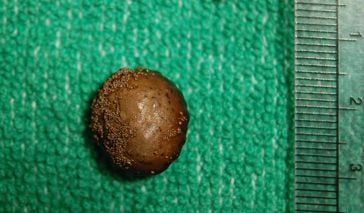Most bladder stones treatment involve removing the stone. But addressing the underlying problem—such as an enlarged prostate (benign prostatic hyperplasia)—is equally important and acts as a preventative measure to keep stones from occurring again.
While some patients may be asked to increase their water intake to help the stones pass naturally, surgical removal is often necessary for bladder stone treatment, especially when the stones result from an obstruction that prevents the bladder from emptying completely. Other medical options exist: Stones can be dissolved with a chemical solution or by changing the urine's acidity. But because these bladder stone procedures take longer, they're not often used as a primary treatment.
The main options for removal include surgery, stone fragmentation, or a combination of the two.
Breaking Up Bladder Stones
When bladder stones are too large to pass naturally from the bladder, they can be fragmented with a procedure called transurethral cystolitholapaxy. In this approach, a small tube with a camera (cystoscope) is inserted into the urethra (the tube that carries urine from the bladder out of the body) and guided into the bladder. Once the stone is located, it is shattered using an ultrasound or a laser, then is then flushed out of the bladder with fluids.
This procedure requires the use of local anesthesia, and patients are often given antibiotics to reduce the risk of infections. Complications are rare, but urinary tract infections, fever, bladder tears, and bleeding can occur.
Bladder Stones Surgery
Surgery may be required if a stone is too big or solid, if multiple stones exist, or if the urethra has been damaged in previous operations (such as bladder reconstruction).
In some cases, a small incision is made in the skin and bladder for a cystoscope to be inserted. The stone is then broken into smaller pieces using an ultrasound pulse, or removed whole through the cystoscope or with forceps.
Surgery complications include infection of the bladder or urethra, bleeding, urine leakage, and pain or discomfort.
Bladder Stone Lithotripsy
During shock wave therapy, or lithotripsy, for bladder stones, an external beam of sound is used to break up the stone. This procedure has a high success rate and sometimes avoids the need to insert instruments through the urethra, unless a stone is too large or hard to be fractured by the shock waves themselves. Since the technique is non-invasive, there is only slight discomfort and pain.
Lithotripsy takes about an hour and requires a local anesthetic to keep the patient comfortable and to prevent shifting. A urologist uses an X-ray or ultrasound to locate the bladder stone before performing one of two methods to break apart the stone. In the most common method, the patient lies down on a water-filled cushion. The shock waves—compressed sound—pass through the cushion to break up the stone in his bladder. Once the stone has shattered, the fragments may pass naturally through the urethra or, if larger, can be removed with a cystoscope.
Monitoring Bladder Stones
The doctor may require a follow-up visit three to four weeks later to perform a CT scan, X-ray, or ultrasound to make sure all of the bladder stone fragments were removed. A patient's blood levels may also be monitored, as an overactive thyroid or elevated uric acid levels can contribute to bladder stone formation.
References
American Urological Association: Clinical Guidelines: Ureteral Calculi. 2007.
Basler J, Fields Schwartz B. “Bladder Stones.” MedScape Reference.
Tugcu V, Polat H, Ozbay B, Gurbuz N, Eren GA, Tasci AI. Percutaneous versus transurethral cystolithotripsy. J Endourol. 2009; 23(2):237-41.
Wein AJ, Kavoussi LR, Novick AC, et al. Campbell-Walsh Urology, 10th ed. 2011.


